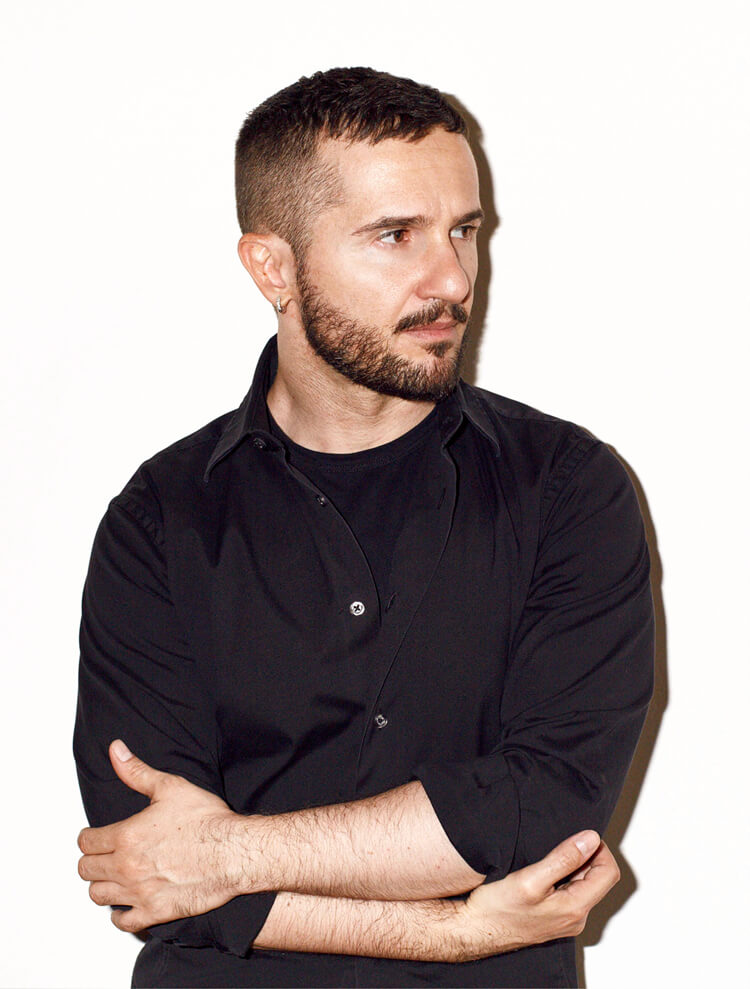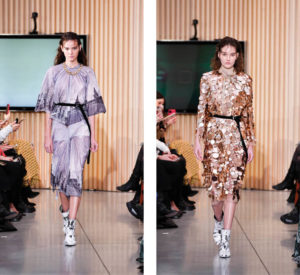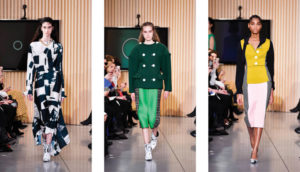Gilberto Calzolari has had dreams of creating his own fashion line since he was a child. Born in Milan, he worked under some of Italy’s finest designers, learning their craft and finding the right formula to launch his own label.

Calzolari soon realised his real passion lies in producing sustainable fashion. He wanted to create designs that are kinder to the planet but still have the same, if not more glamour and quality of regular pieces. The designer first stepped into the spotlight for his sustainable creations when he won the prestigious Franca Sozzani Green Carpet Award for Best Emerging Designer in 2018 for his dress created from used coffee bean bags. He went on to create his first collection made from fully sustainable materials and successfully carved out a niche for himself in the Italian fashion business at a time when few were doing anything of this level in relation to sustainability.
Since then he has continued to create sustainable fashion designs that women really want to wear. His approach to manufacturing is sustainable, but so too are his choice of materials. Calzolari has a unique talent for repurposing unwanted materials and creating something new. This could be anything from coffee bean bags, to broken umbrellas to fruit packaging. His unique eye allows him to be creative and at the same time help to save the planet.
His latest collection can’t be segmented into spring/summer or fall/ winter as it is a year-long collection, designed to meet the needs of consumers all year round and minimise waste from throwaway seasonal garments that are only worn for a few months. The collection was presented on the runway at Milan Fashion Week earlier this year; something that has been a dream of the young designer since he was a child. Here we discuss his continued effort in to lead the way of sustainability in the fashion industry and the experience of achieving his dream to present on-schedule at Milan Fashion week for the first time.
What can you tell us about the One-Year-Long collection that you have been working on for this year?
For my latest collection; “Tilt System”, I decided to get rid of the seasonal approach in favour of a year-long collection. I see it as a coherent step-forward in my path towards sustainability, which is not only expressed through the choice of materials but also in the production cycles with a “slow fashion” fashion approach. This also sees a return to tailored quality and exclusivity and breaks from the traditional seasonal model by offering an eclectic and surprising year-long collection, which touches all seasons.
What was the inspiration for the collection?
I see fashion as the perfect mirror of what is happening around us – a looking glass, at first faithful and distorted, that projects illusions but also reveals the deepest signals of our society, a society that is compelled to a radical change and demands new rules. While social networks flaunt wonderful fake lives, a world full of contrasts highlighted a system on tilt, where nature struggles under a severe climate change, seasons have lost their meaning, and a global crisis forces us to reinvent ourselves. This is the premise of my latest collection, and its title, “Tilt System” in a way anticipated the situation we are all living today. The truth is, the signs of a society on tilt were already there, way before the pandemic. In my new collection, I just decided to put a spotlight on them.

How do you think seasons are changing when it comes to fashion these days?
The current seasonal approach makes no sense, for several reasons. First of all, also from a climatic standpoint, due to climate change, seasons overlap more and more, and there’s a need for a more diverse wardrobe all year long. Moreover, from a sustainable point of view, we need to re-wire the system. It all started when high fashion decided to follow the rhythms of fast fashion, which brought an absurd frenzy of over-production and over-communication. Do we really need, each season, a pre, main and cruise collection? Do we need to create so many items that will inevitably end up on sale, creating so much pollution and waste? I truly believe high-end fashion needs to go back to a more artisanal approach, which is at the core of the Made in Italy greatness. And I believe that presenting a year-long collection responds to the customer’s needs in a better way. This September, I’ll present “Tilt System Volume 2”, which is the same collection with some variations of fabrics, prints and colours.
You recently presented your collection on-schedule at Milan Fashion Week for the first time – how was the experience?
For many years I worked for some of the most important luxury brands in the world, from Marni to Valentino, Miu Miu to Armani, so, in a way, I knew exactly what to expect, but to open the Milano Fashion Week with my own fashion show was a completely different experience. I felt like a professional athlete who, after many years of hard work, is admitted to the Olympics!
What can you tell us about the work Camera della Moda Italiana is doing to support sustainable fashion?
Nowadays, the challenges for an upcoming brand are immense, even more so if it’s a brand committed to sustainability, and I’m immensely grateful to Camera Moda for their unwavering support. Nowhere in the world, will you find attention and commitment to sustainable fashion like the one Camera Moda has proven since the get-go, which translates every year into a myriad of initiatives.
The world has come to a standstill currently – how do you think attitudes to sustainable fashion might change after this time of crisis?
If anything, I believe the situation we are living will make sustainable fashion even more relevant and imperative. It’s the only way. We owe it to ourselves, to our planet, and the future generations.

What are some of the methods and techniques you use within Gilberto Calzolari to ensure sustainable production?
My commitment to sustainability comes to life in various ways. In particular, when I create a collection, I follow 3 directions:
- The use of cutting-edge and technologically, advanced and environmentally friendly fabrics of natural origin, compliant with the most reliable certificates in terms of sustainability and traceability.
- The recycling of existing materials, such as beautiful stock fabrics discovered in renowned Italian textile companies.
- The upcycling of unusual materials transformed into couture fabrics: from the dress made with jute coffee bags and embroidered with lead-free Swarovski crystals, that earned me the Green Carpet Award as Best Emerging Designer, to the tulle coming from the nets for citrus packaging; from the clothes created with exploded airbags and discarded safety belts to those made with canvases of broken umbrellas.
Can you tell us about some of the materials you have worked with for your recent collection?
My latest collection features a multifaceted wardrobe where “women’s” cuts are paired with “men’s” fabrics and details, winter and summer clothes together, and styles from different eras collapse into unusual combinations. But there are always glamorous silhouettes, made from a variety of materials including patterned wool from regenerated yarns; organza and crepe de chine in 100% organic and GOTS-certified silk; fake-fur; recovered vinyl and neoprene. Semi-gloss satins of recycled polyester from PET bottles, in a mix of avant-garde, are sustainable fabrics on one hand and on the other, splendid warehouse stock fabrics discovered among reputable textile companies. Then there is the upcycling of unusual and original materials, which is a signature in my collections: in this case, dresses have been created from recovered sheets from broken umbrellas.
You have been an advocate for sustainable fashion for a long time but how have you seen attitudes and approaches to it changing over the years?
It’s been a constant process. I feel that in every collection I learn more about sustainability. Quite honestly, in the past two years, the landscape has improved a lot. This is thanks to new technologies, which mean you can find more and more sustainable fabrics, such as, to name a few, SEQUAL polyester derived from plastic recovered from the sea or EVO nylon extracted from the seeds of the castor plant. Soon we will be able to test fabrics made from grapes and mushrooms… there are no limits to the roads sustainability can take.
What still needs to be done in the fashion industry in relation to sustainability?
There’s still a lot of work to do. Producing sustainable fashion is still very expensive, starting with the costs of fabrics and processes. Only with greater cohesion and collaboration throughout the whole supply chain, from the supplier to the manufacturer, from the distributor to the seller, can we really make a change, so that people can perceive not only the importance but also the beauty – which is both ethical and aesthetical – of sustainable fashion. In this regard, we suffer from a lack of real communication and promotion towards the end consumer. There aren’t many retailers (be it boutiques or department stores) who pay serious attention to sustainable fashion and this is a problem considering that they are the ones who have direct contact and a relationship with the customers. I realise that although there is a lot of talk about sustainability nowadays, many still believe that sustainable fashion is somehow less glamorous.
This perception is completely wrong. The reality is diametrically opposite. Sustainability can and must be beautiful, glamorous and classy. It’s the only way high-end fashion can contrast the damages of fast fashion and prove its superior craftsmanship.
Moving forward what do you expect to see from the behaviour of consumers concerning sustainable fashion?
The paradox is that the end consumer seems more and more interested in sustainable fashion, especially the new generations who are much more aware of what they are wearing. But we have to put them in a position to be able to choose sustainable alternatives and to do this we need an important boost from the distribution, whether they are department stores or multi-brand boutiques because they are the ones who can make sustainability a real option.
Will you be changing any of the strategy of the company after the current global pandemic?
The main change right now is that the current situation forces us to be more digital. I’m working on an e-commerce platform that will offer pieces on a made-to-order basis. People want to have a more dedicated experience, and I believe that they are willing to wait a few weeks to receive an item that is created especially for them to avoid unnecessary waste. We must go back to making fashion an object of desire for which it is worth waiting. If this is what is good for our planet: true luxury does not lie in having everything at once, but in experiencing the exclusivity of craftsmanship sustainably and consciously, knowing that with your purchase you have been impacting less on the environment.
What is the professional motto you live by?
I often use the term “conscious glamour” when I talk about my brand and my vision. My mission has always been to prove that being sustainable means being chic and deeply creative. The woman I dress loves the environment but does not give up on glamour and style. Our job is to create beauty and sustainable fashion that’s twice as beautiful – aesthetically and ethically.
What is something that you would still like to achieve with the brand that you haven’t done yet?
I would one day like to be able to open a flagship store with a sustainable footprint in my city of Milan. Or perhaps in Tokyo, Japan, a country with a culture and an aesthetic very similar to my philosophy of life – a place of deep-rooted elegance and surprising contrasts where tradition and innovation live side by side.
Where would you like to see the fashion industry in terms of sustainable fashion in 10 years?
My dream is that in 10 years sustainable fashion will be the norm, so much so that we’ll no longer have to ask or specify if a garment is made with sustainable fabrics and according to protocols of social responsibility because it would be outrageous to imagine otherwise.
What are the things we as consumers should be doing in order to be more sustainable when it comes to our fashion choices?
Reduce, reuse and recycle. Buy less but buy smart!
What does the rest of 2020 have in store for Gilberto Calzolari?
It’s hard to make long-term plans in the current situation, which is constantly evolving. For example, it’s still not clear if and how the fashion week in September will take place. But the long-term goal is clear. The pandemic has forced everybody to reconsider their priorities, and the one thing I know is that we need to put sustainability at the centre of our industry.















